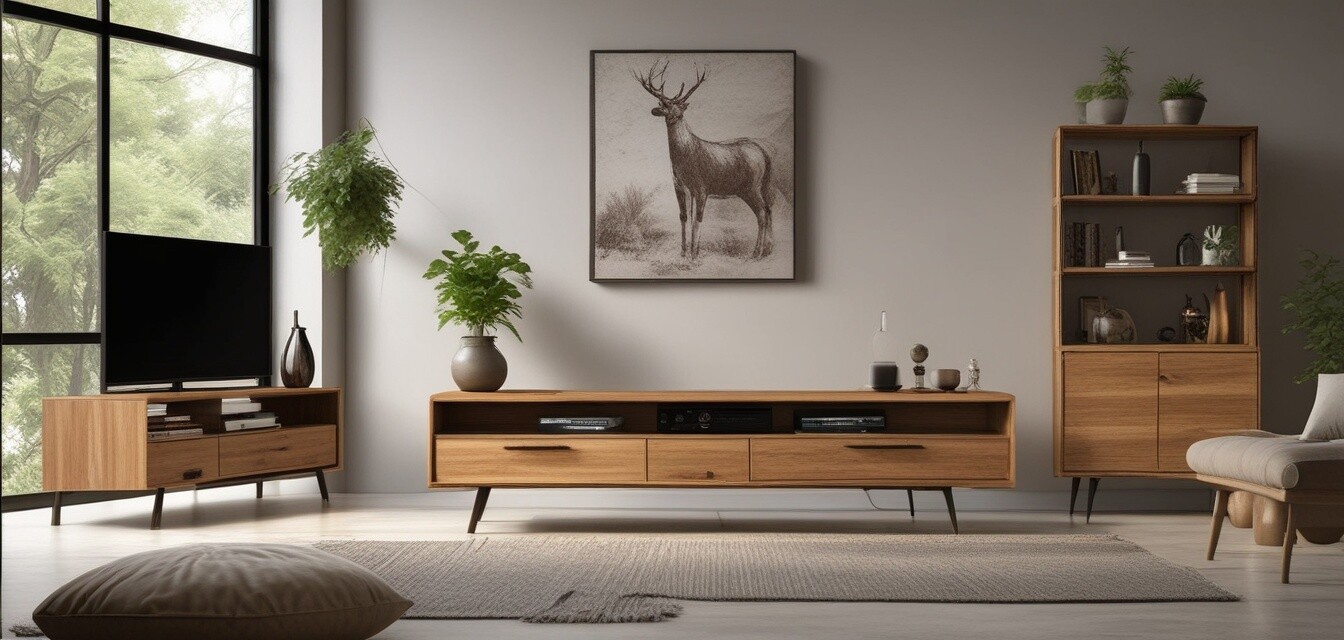
Global trends in sustainable furniture design
- Growing importance of eco-friendly materials in furniture design.
- Innovative designs reflect cultural aesthetics.
- Focus on functionality and sustainability enhances user experience.
- Emerging trends in modular and multifunctional furniture.
- Incorporating natural elements is a key trend in modern design.
As the world becomes increasingly aware of environmental issues, sustainable furniture design has emerged as a critical trend in the furniture industry. This article delves into global trends in sustainable furniture, highlighting innovative TV stands and how different cultures contribute to the evolution of eco-friendly designs.
The rise of sustainable materials
The furniture industry is witnessing a significant shift towards the use of sustainable materials. Homeowners are becoming more conscious of their environmental footprint and seeking out options that reflect their values. Some commonly used sustainable materials include:
- Reclaimed wood: Salvaged from old buildings, this material reduces waste and gives a unique character to each piece.
- Bamboo: A fast-growing grass that is incredibly strong and renewable, making it an excellent alternative to traditional woods.
- Cork: Harvested from the bark of the cork oak tree, it is recyclable and biodegradable.
- Recycled metals and glass: Perfect for modern designs and greatly reduce the carbon footprint in production.
Innovative designs from around the globe
Different cultures offer unique perspectives on sustainable furniture design. Here are some notable innovations in TV stands from various regions:
| Region | Innovative Design Features | Common Materials |
|---|---|---|
| Scandinavia | Minimalist aesthetics with multifunctional capabilities | Bamboo, reclaimed wood |
| Japan | Fusion of traditional craftsmanship with modern designs | Cypress, bamboo |
| Brazil | Integration of local flora designs and sustainability | Reclaimed tropical woods, eco-friendly finishes |
| North America | Adaptability in form and function, catering to urban lifestyles | Recycled metals, reclaimed lumber |
Emphasis on functionality
As consumers seek furniture that fits their busy lifestyles, the demand for multifunctional designs is increasing. Modern TV stands are not just about aesthetics; they must also serve practical purposes. Here are some popular features:
- Storage solutions: Incorporating shelving and drawers helps keep living areas tidy.
- Modular components: Allowing customers to customize their setups based on space and needs.
- Adjustable heights: Providing options for user comfort.
For more insights, check our articles on Buying guides for furniture that fits your needs.
Natural elements in design
Incorporating natural elements into furniture design enhances the organic feel of living spaces. This trend can manifest through:
- Natural finishes: Using stains and coatings that highlight the wood grain.
- Organic shapes: Emphasizing curves and flowing lines, reminiscent of nature.
- Living plants: Integrating planters into furniture designs adds breathability to spaces.
The future of sustainable design
As eco-friendly living continues to rise in popularity, we can expect to see more innovative designs that prioritize sustainability. Here are some trends set to shape the future of furniture design:
- Smart furniture: Integrating technology to improve efficiency and user experience.
- Upcycling: Reimagining and repurposing older furniture pieces for modern use.
- Biomimicry: Designing based on biological processes to create sustainable items.
Conclusion
The influence of global trends in sustainable furniture design is evident as consumers move towards more environmentally friendly options. Innovative TV stands showcase interactive designs that blend aesthetics with functionality, and the use of sustainable materials is on the rise. By embracing these trends, we can create beautiful environments while also protecting our planet for future generations. To learn more about sustainable practices in furniture, explore our section on Eco-Friendly living.
Pros
- Environmentally friendly materials contribute to sustainability
- Innovative designs enhance functionality and user experience
- Support for local artisans and craftsmen
- Unique aesthetics that cater to personal style
Cons
- Potentially higher costs compared to traditional furniture
- Limited availability in some regions
- May require more care and maintenance